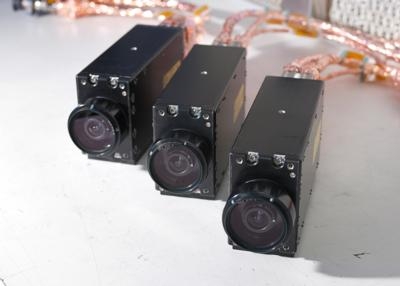Sun, Jul 21, 2013
First Avionics Hardware Completed For The Unmanned Test Flight
Three flight cameras have been installed on the Orion Exploration Flight Test (EFT-1) crew module by prime contractor Lockheed Martin. The cameras, developed by Ball Aerospace, are the first avionics hardware completed for the EFT-1, which is scheduled to launch in September 2014.

Orion is the nation's first interplanetary spacecraft designed to carry astronauts beyond low-Earth orbit on long-duration. Orion's Testing and Verification program at Lockheed Martin continues to validate hardware and software integration, test subsystems and refine production operations to ensure the Orion team builds the safest, most reliable spacecraft possible to successfully execute a series of increasingly challenging human exploration missions on the path to Mars.
The Ball cameras are based on the design of the docking camera that flew aboard the STS-134 Sensor Test for Orion Relative Navigation Risk Mitigation (STORRM) mission in 2011. STORRM was an innovative technology development effort led by NASA's Multi-Purpose Crew Vehicle Project Office at NASA Johnson Space Center in partnership with NASA Langley Research Center, Lockheed Martin, and Ball Aerospace. The on-orbit test validated the performance of the navigation sensor suite for Orion and other future spacecraft by demonstrating a robust relative navigation design that provided the required docking accuracy and range capability necessary to meet crew safety, mass, volume and power requirements for a wide variety of future NASA missions, including those into deep space.
The new ultra-wide-field cameras for Orion EFT-1 have enhanced software and exposure controls, and will be positioned in various windows on the spacecraft in order to monitor the test flight as different procedures are carried out. Variations of the cameras are planned for each Orion flight. In addition to providing test and docking cameras, the company is producing the conformal phased array antennas and star trackers that will be installed on each Orion launch system. The first human-rated Orion mission is slated for 2021.
(Image provided by Ball Aerospace.)
More News
An Amazing Experience Awaits The Chosen Few... Oshkosh, to us, seems the perfect place to get started on watching aviation recover the past couple of years... and so ANN is putting>[...]
“NBAA has a tremendous responsibility to the business aviation industry, and we are constantly collaborating with them. Our flight departments, professionals and aircraft own>[...]
Dead Reckoning Dead reckoning, as applied to flying, is the navigation of an airplane solely by means of computations based on airspeed, course, heading, wind direction, and speed,>[...]
Aero Linx: Vertical Aviation Safety Team (VAST) We are a public–private initiative to enhance worldwide flight operations safety in all segments of the vertical flight indust>[...]
We're Everywhere... Thanks To You! Even with the vast resources and incredibly far-reaching scope of the Aero-News Network, every now and then a story that should be reported on sl>[...]
 ANNouncement: Now Accepting Applications For Oshkosh 2024 Stringers!!!
ANNouncement: Now Accepting Applications For Oshkosh 2024 Stringers!!! Aero-News: Quote of the Day (06.13.24)
Aero-News: Quote of the Day (06.13.24) ANN's Daily Aero-Term (06.13.24): Dead Reckoning
ANN's Daily Aero-Term (06.13.24): Dead Reckoning ANN's Daily Aero-Linx (06.13.24)
ANN's Daily Aero-Linx (06.13.24) ANN FAQ: How Do I Become A News Spy?
ANN FAQ: How Do I Become A News Spy?



